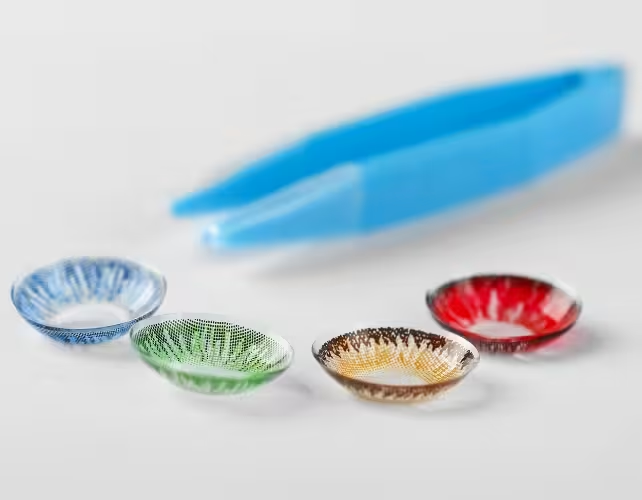6 Minutes
As Halloween approaches, novelty contact lenses promise dramatic transformations — from milky horror eyes to vibrant, theatrical hues. But beneath the cosmetic thrill lies a real public-health issue: poorly manufactured or improperly used costume lenses can cause irritation, infection, scarring and even permanent vision loss. Here’s what eye-care professionals want you to know before you buy or wear them.
Why costume contact lenses can be dangerous
Contact lenses are regulated medical devices designed to sit directly on the cornea, the clear front surface of the eye. If those lenses are poorly fitted, contain unsafe pigments, or are stored and handled incorrectly, they create an entry point for bacteria, fungi and protozoa. Infections such as keratitis — inflammation of the cornea — can rapidly damage vision. In severe cases, a corneal ulcer can form, leaving scars that permanently reduce visual acuity.
Several studies of cosmetic lenses sold informally show contaminants and unauthorized dyes, and even traces of metals like iron or chlorine in the pigment layers. These substances can irritate the ocular surface, trigger allergic responses, and, importantly, increase microbial adhesion to the lens. That adhesion makes it easier for microorganisms to colonize lenses and then transfer to the eye.
Common mistakes that raise infection risk
Many people who buy novelty lenses have never worn contacts before — and may never use them again. That inexperience raises the odds of incorrect handling. Frequent errors include:
- Rinsing or storing lenses in tap water or homemade saline. Water can contain Acanthamoeba, a protozoan that causes a rare but devastating infection of the cornea.
- Cleaning lens cases with water rather than with approved contact-lens solutions.
- Wearing lenses longer than recommended or sleeping with them in when they are not approved for overnight wear.
- Sharing lenses with friends — a practice that dramatically increases transmission risk.
All of these mistakes can introduce pathogens or damage the corneal epithelium, the thin protective layer on the eye surface. Once that barrier is compromised, bacteria such as Pseudomonas aeruginosa, fungi or Acanthamoeba can invade, leading to painful, sight-threatening infections.

Material and manufacturing matter
Not all lenses are created equal. Certified contact lenses are manufactured under standards regulated by national bodies (for example, the Spanish Agency of Medicines and Medical Devices, AEMPS). Approved lenses use biocompatible materials that allow oxygen to reach the cornea and employ safe pigments that are sealed away from the eye. By contrast, unregulated novelty lenses may use unauthorized dyes that flake or leach, and surface textures that trap microbes.
When pigments increase microbial adhesion, even meticulous hygiene may not fully eliminate risk. That is why eye-care professionals recommend buying lenses only from licensed retailers and only after a professional fitting and exam by an optometrist or ophthalmologist.
How to use costume contacts safely
- Consult an eye-care professional before buying. A proper fitting reduces mechanical injury and ensures the lens is compatible with your eye shape and tear film.
- Purchase lenses from a reputable supplier and confirm the product is a regulated medical device.
- Practice strict hand hygiene before handling lenses; use only manufacturer-approved cleaning and storage solutions.
- Never use water or saliva to clean lenses or lens cases. Water can carry Acanthamoeba and other microbes.
- Remove lenses immediately if you feel irritation, redness, pain, light sensitivity or blurred vision; consult an eye-care professional promptly.
- Never share lenses, and always insert them before applying makeup to avoid contamination.
- Follow manufacturer guidance on maximum wear time; do not sleep in lenses unless explicitly approved for overnight wear.
Simple precautions dramatically reduce the risk of corneal abrasions and infections. Think of contact-lens safety as eye-first costume planning: a brief consultation and careful handling can prevent a permanent, avoidable injury.
Scientific context: infections and the cornea
Keratitis and corneal ulcers illustrate how quickly an ocular surface problem can escalate. Keratitis is inflammation that can be caused by bacteria, viruses (such as herpes simplex), fungi or protozoa like Acanthamoeba. Symptoms include severe pain, tearing, light sensitivity and decreased vision. Corneal ulcers are open sores on the cornea; they can form when infectious organisms invade deeper layers after a surface injury. Treatment often requires topical antibiotics or antifungals, and in the worst cases corneal transplantation.
From a public-health standpoint, outbreaks associated with cosmetic lenses are preventable. Surveillance and consumer education, combined with enforcement of medical-device regulations, reduce incidence. Eye-care professionals also emphasize that early recognition and rapid treatment of symptoms greatly improve outcomes.
Expert Insight
"Costume contact lenses are not harmless accessories," says Dr. Elena Márquez, ophthalmologist and cornea specialist. "A single overnight use of an improperly fitted or contaminated lens can lead to infections that require intensive treatment and, in rare cases, surgery. If you plan to use them, see an eye-care professional first — and follow the hygiene rules precisely."
Dr. Márquez adds that while AI-driven resources and online tutorials can provide general advice, they cannot replace a clinical exam. "An experienced clinician assesses tear film quality, corneal curvature and ocular surface health. Those factors determine whether a lens is safe for a given patient."
When to seek immediate care
If you experience any of the following after inserting novelty contacts, remove the lenses and seek emergency ophthalmic care:
- Intense eye pain or a foreign-body sensation that persists after lens removal
- Marked redness, discharge, or an eye that refuses to open in bright light
- Sudden worsening of vision or persistent blurring
Timely diagnosis and treatment protect not only short-term comfort but long-term vision.
Source: sciencealert


Leave a Comment